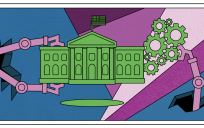The US government, as the largest employer in the country, plays a critical role in promoting diversity, equity, inclusion, and accessibility (DEIA) within its workforce while setting an example for the private sector. For more than 20 years, the government has had DEIA reporting policies such as MD–715, which provides a roadmap to create effective equal employment opportunity (EEO) programs for federal employees. Recently, the Biden administration has made a big push to strengthen DEIA measures through executive orders, training programs, and strategic planning initiatives.
Yet, to bridge the gap between comprehending and talking about the importance of DEIA and taking action, federal agency leaders must press GO on investing in the personnel, technology and systems that will support a robust DEIA program.
The Current Federal Agency Diversity Landscape
According to a study conducted by the Government Accountability Office (GAO), federal agencies have achieved mixed success in increasing workforce diversity. While certain agencies, like those within the intelligence community, have seen improvements in minority representation, they have yet to meet federal benchmarks. Similarly, while the federal pay gap between genders is smaller than the national average, pay disparities persist. Additionally, hiring of disabled persons has exceeded goals, but retention remains low.
Leveraging Technology for Impactful Change
Technology can play a pivotal role in advancing effective DEIA initiatives within government agencies. Online platforms and recruiting tools can expand access to an increasingly diverse pool of candidates. In hiring and advancement, agencies can harness AI-powered tools to identify and remove unconscious bias from hiring and promotion processes.
Moreover, technology can ensure workers with limited mobility, illness, or in underrepresented groups can apply for and perform jobs remotely.
Plus, technology opens the door for digital DEIA training and education programs, enables data-driven decision making, and creates inclusive digital spaces for collaboration and idea sharing.
By leveraging leading-edge technology, federal agencies can drive change, track progress, become more responsive and flexible, and, ultimately, drive meaningful change in fostering a more inclusive work environment. But technology alone isn’t enough. To accelerate DEIA progress, federal agencies must also implement a few key strategies.
Winning Strategies to Battle Workforce Biases
The 2022 Federal Employees Viewpoint Survey (FEVS) included, for the first time, an index to assess employee viewpoints on DEIA programming. The survey showed that almost 70% of federal employees think their agency is doing a decent job on DEIA, but that there is plenty of work still to be done implementing policies that turn good intention into meaningful action.
Here’s how agencies can get started.
- Empower Managers to Take Action
First, agencies should have or have considered filling the Chief Diversity Officer (CDO) role to proactively manage DEIA programming and reporting. But even if an agency can’t fund a CDO position, agency leaders should be allocating time and budget for existing workforce management and HR staff to take advantage of resources being provided by OPM’s CDO council, including meetings, summits, and research.
Agency heads and department heads must empower leaders and managers to act as change agents and role models. They need permission to host workshops, procure training materials, and bring in experts to begin the difficult work of creating change. Providing permission, funding, tools, examples, and metrics for accountability can support leaders in embedding DEIA into their everyday practices.
- Create a Common Understanding of DEIA
Second, the CDO council should be creating a common understanding and shared language around DEIA that can be scaled across government and adopted for agencies small and large. This mutual understanding is crucial to aligning employee perceptions with agency intentions. Clear communication of DEIA definitions and goals fosters a shared vocabulary and facilitates consistent action.
Additionally, agencies should closely connect DEIA efforts to mission outcomes, emphasizing that fair and equitable workplaces enhance productivity, innovation, and constituent service.
- Focus Hard on Bias Mitigation
Agencies need to focus on systemic changes to mitigate unconscious bias. While hiring gaps have begun closing on race, gender, and ability, data still shows that turnover is higher in marginalized populations. Analyzing policies, procedures, and culture, coupled with unconscious bias training, can help identify and address hidden biases to increase retention.
- Reinvent Federal Recruitment Practices Aligned with DEIA
Reinventing federal recruitment practices is essential to attract a diverse talent pool. Streamlining hiring processes, reaching broader talent markets, and leveraging DEIA as a differentiator can enhance diversity in federal agencies.
The Journey to Achieving DEIA
Achieving DEIA will require a comprehensive strategy and the right people and tools to begin implementing and testing different tactics. While progress has been made, there is still much work to be done. By leveraging technology, empowering leaders, fostering a common understanding, and addressing unconscious bias, federal agencies can accelerate their DEIA efforts. While achieving DEIA will not be easy, it’s a destination that’s worth the difficult journey. With an inclusive work environment, the government can enhance productivity, innovation, and constituent service, setting a powerful example for other sectors to follow.
Russell Miller is Director of Implementation, Government Workforce Management, OPEXUS. Russell has extensive experience providing implementation support for the HR Product Suite at OPEXUS. His expertise helps ensure products are delivered on time and on budget. He is passionate about using technology to improve the day-to-day functionality across government HR processes. In his free time, Russ enjoys Boston’s sport events, boating, and spending time with his family.





Leave a Reply
You must be logged in to post a comment.